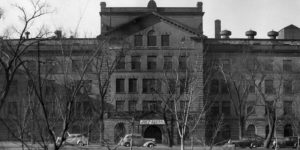North Central During the Vietnam War

North Central University is a hidden gem woven into the busy streets of Minneapolis. With countless degrees, classrooms, activities, and opportunities for outreach, North Central has established a noticeable presence within the city. In celebration of the university’s Christ-centered success, The Northerner wants to take a look back in time and highlight North Central’s development during meaningful times in history.
This article will be focusing on the period of the Vietnam War. What did North Central look like between 1955-1975? In 1955, when the war was just beginning, North Central was known as North Central Bible Institute, being renamed North Central Bible College two years later in 1957.
According to the NCU Magazine, in 1955 NCBI was pushed by increased enrollment to add “3 bachelors of arts programs: theology, religious education, and missions.” We must add a warning for this next piece of information due to the painful nature of rising costs today: tuition that year at NCBI was a whopping $108 per semester… By this time, NCBI has graduated 1,423 students and the majority went on to occupational ministry (NCU Magazine, 2020).
In 1960, the student newspaper still existing today was named The Northern Light. Just a year later, “Founder F.J. Lindquist resigns as President of NCBC and continues teaching until 1963” (NCU Magazine, 2020). Alongside Lindquist’s resignation, I.O. Miller attempted to resign twice, but both resignations were rejected. After a third and final time, Miller’s resignation was approved, and “Professor G. Raymond Carlson is named the second president of NCBC” (NCU Magazine, 2020).
In 1962, with enrollment being just 350 students NCBC joins the Minnesota River Athletic Conference with men’s basketball and baseball teams (NCU Magazine, 2020).
For a sliver of historical context, just two years later in 1964, the U.S. formally entered the war after the Gulf of Tonkin Incident also known as the U.S.S. Maddox Incident. In a 2020 article from History, Jessica Rotondi wrote, “On August 2, 1964, the U.S.S. Maddox encountered three Soviet-built North Vietnamese torpedo boats in the Gulf of Tonkin. The Maddox fired what it described as warning shots and was met by torpedo and machine gun fire.”
A large part of NCBC’s success was the acquisition of multiple buildings and properties that surrounded the area. From the NCU Magazine, here is a breakdown of how the university expanded:
“NCBC acquires the parcel of land, including multiple housing structures, at the corner of Chicago Avenue and 9th Street. The final building on this land would be demolished in 1990 to create additional parking space, the so-called “Triangle Lot.” The land later becomes the site of Phillipps Hall. 1968: On Christmas Eve, NCBC acquires from the Methodist Episcopal Church the 2 remaining Asbury Hospital buildings—the Tourtellotte Memorial Deaconess Home at 915 E. 14th St., and a nurse’s residence at 916 E. 15th St.—but does not take possession until August 1969.”
In 1968, the 15th street building received the name G. Raymond Carlson Hall but only a year later, Carlson resigned as president of the university to become Assistant General Superintendent of the Assemblies of God (NCU Magazine, 2020). Presidency then changed hands rapidly. In 1970, Rev. Cyril Homer becomes the third President, 6 months later he resigns followed by Rev. E.M. Clark becoming the fourth president in 1971 (NCU Magazine,2020).
The final milestones for NCBC during the period of the war were the building of the new chapel and the establishment of the Deaf Studies Department. The construction of the new chapel presented quite the bill. $130,000 had already been put towards the project with another $95,000 remaining to be raised. During spiritual emphasis week, students came together to sell all kinds of personal belongings, even their cars, to close the financial gap needed to complete the project. Students raised an astounding $25,000 which, amongst other donations, helped complete the new chapel building in 1973 (NCU Magazine, 2020).
In 1974, “Rev. J. David Flack pioneers the Deaf Studies Department; the department offered a 3-year diploma to deaf students preparing for occupational ministry” (NCU Magazine, 2020). During this year, enrollment rose to 450 students, and just one year later in 1975, the war was over.
For more information on the history of North Central University visit: NCU Magazine Fall 2020 Issue.
References:
NCU Magazine Fall 2020 Issue
Rotondi, J. P. (2020, August 20). 6 events that laid the groundwork for the Vietnam War. History.com. Retrieved October 3, 2022, from https://www.history.com/news/vietnam-war-origins-events
What did North Central look like between 1955-1975?





